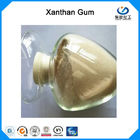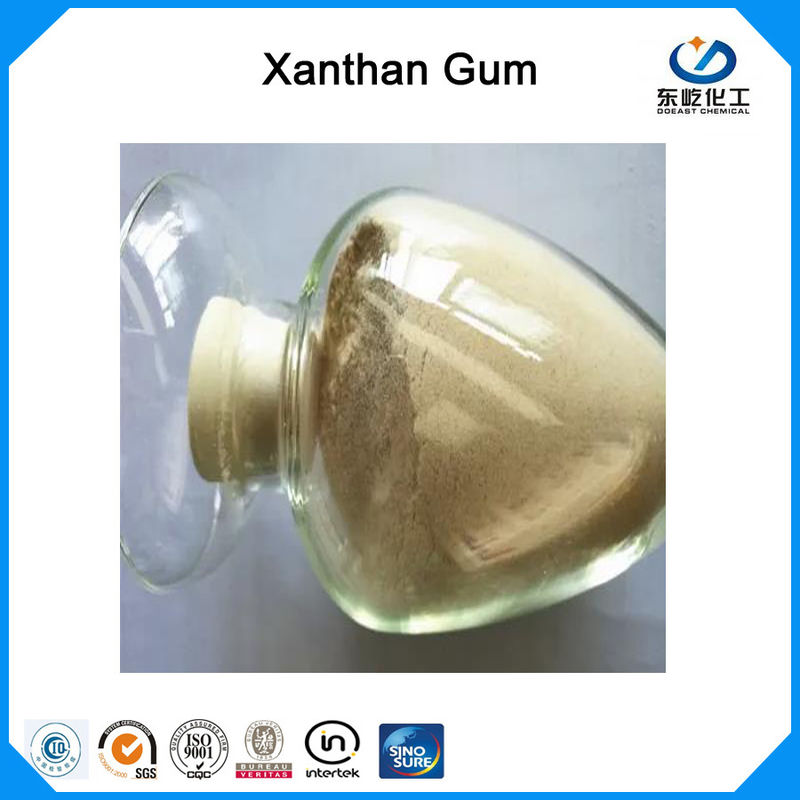Xanthan gum description:
Xanthan gum is an anionic polysaccharide composed of β-(1→4)-D-glucopyranose glucan backbone, and the side chain is (1→3)-α-D-mannanose-(2→ 1)-β-D-glucuronic acid-(4→1)-β-D-mannanose is alternately linked to the residues. Approximately half of the terminal mannose residues are 4,6-pyruvate, while most of the internal mannose residues are 6-acetylated. Its properties make it a useful matrix component for drug delivery systems. It forms a stable drug suspension in an aqueous medium and forms a soft gel with locust bean gum or guar gum. Studies have adopted a mouse model, using xanthan gum to simulate the texture of lipids and used as an experimental control to study the signaling pathways triggered by the consumption of lipid-containing reagents.

Special package can be provided as per customers' requirements.

structure
Xanthan gum, also known as xanthan gum and xanthan gum, is an extracellular acidic heteropolysaccharide produced by the fermentation of Xanthomonas spp. It is a 2:2:1 polysaccharide polymer compound composed of D-glucose, D-mannose and D-glucuronic acid, with a relative molecular mass of more than 1 million. The secondary structure of xanthan gum is that the side chain is wound around the backbone of the main chain in a reverse direction, which is maintained by hydrogen bonds to form a rod-like double helix structure.
Performance characteristics
Xanthan gum is currently the internationally most superior bio-gum that integrates thickening, suspension, emulsification, and stability. The number of pyruvate groups in the molecular side chain ends of xanthan gum has a great influence on its performance. Xanthan gum has the general properties of long-chain polymers, but it contains more functional groups than general polymers, and will show unique properties under certain conditions. Its conformation in aqueous solution is diverse and exhibits different characteristics under different conditions.
1. Suspension and emulsification
Xanthan gum has a good suspending effect on insoluble solids and oil droplets. Xanthan gum sol molecules can form a super-bonded ribbon-like spiral copolymer, forming a fragile glue-like network structure, so it can support the shape of solid particles, droplets and bubbles, showing strong emulsification stabilization and high suspension ability.
2. Good water solubility
Xanthan gum can quickly dissolve in water and has good water solubility. Especially it can dissolve in cold water, which saves complicated processing and is convenient to use. However, due to its strong hydrophilicity, if water is directly added and the stirring is not sufficient, the outer layer will absorb water and expand into a micelle, which will prevent water from entering the inner layer, thereby affecting its function. Therefore, it must be used correctly. Xanthan gum dry powder or dry powder auxiliary materials such as salt and sugar are mixed well and then slowly added to the stirring water to make a solution for use.
3. Thickening
Xanthan gum solution has the characteristics of low concentration and high viscosity (the viscosity of 1% aqueous solution is equivalent to 100 times that of gelatin), and it is an efficient thickener.
4. Pseudoplasticity
The xanthan gum aqueous solution has high viscosity under static or low shear action, and under high shear action, the viscosity drops sharply, but the molecular structure remains unchanged. When the shearing force is eliminated, the original viscosity is immediately restored. The relationship between shear force and viscosity is completely plastic. The pseudoplasticity of xanthan gum is very prominent, which is extremely effective for stabilizing suspensions and emulsions.
5. Stability to heat
The viscosity of the xanthan gum solution will not change greatly with the change of temperature. The viscosity of general polysaccharides will change due to heating, but the viscosity of the xanthan gum solution will hardly change between 10-80℃, even at low concentrations. The aqueous solution still shows a stable high viscosity in a wide temperature range. Heat 1% xanthan gum solution (containing 1% potassium chloride) from 25°C to 120°C. Its viscosity is only reduced by 3%.
6. Stability to acid and alkali
Xanthan gum solution is very stable to acid and alkali, and its viscosity is not affected when the pH is 5-10. When the pH is less than 4 and greater than 11, the viscosity changes slightly. In the range of PH3-11, the difference between the maximum and minimum viscosity is less than 10%. Xanthan gum can be dissolved in a variety of acid solutions, such as 5% sulfuric acid, 5% nitric acid, 5% acetic acid, 10% hydrochloric acid and 25% phosphoric acid, and these xanthan gum acid solutions are quite stable at room temperature. After a few months, the quality will not change. Xanthan gum is also soluble in sodium hydroxide solution and has thickening properties. The resulting solution is very stable at room temperature. Xanthan gum can be degraded by strong oxidants, such as perchloric acid and persulfuric acid, and the degradation accelerates with the increase of temperature.
7. Stability to salt
Xanthan gum solution can be miscible with many salt solutions (potassium salt, sodium salt, calcium salt, magnesium salt, etc.), and the viscosity is not affected. Under the condition of higher salt concentration, it maintains its solubility even in saturated salt solution without precipitation and flocculation, and its viscosity is hardly affected.
8. Stability to enzymatic hydrolysis
The stable double helix structure of xanthan gum has strong anti-oxidation and anti-enzymatic abilities. Many enzymes such as protease, amylase, cellulase and hemicellulase cannot degrade xanthan gum.
SPECIFICATIONS
Oil grade xanthan gum
| Item |
Standard |
| Type |
DE-VIS |
DEO-VIS |
DEO-VIS D |
DE-PLUS |
DE-PLUS D |
DE-PRE |
DE-PRE D |
| Appearance |
Cream Colored Free Flowing Powder |
| Particle Size |
40/80 Mesh |
| Loss On Drying |
6-14% |
| Ph (1% Solution) |
6~8 |
| Ash |
Less Than 13% |
| Rheological Properties (1 Ppb in Seawater. Measurments Taken Using Fan 35, 0.2 spring) |
| 600 Rpm |
70 min |
75 min |
75 min |
80 min |
80 min |
85 min |
85 min |
| 300 Rpm |
50 min |
55 min |
55 min |
60 min |
60 min |
65 min |
65 min |
| 200 Rpm |
40 min |
45 min |
45 min |
50 min |
50 min |
55 min |
55 min |
| 100 Rpm |
30 min |
35 min |
35 min |
40 min |
40 min |
45 min |
45 min |
| 6 Rpm |
15 min |
18 min |
18 min |
20 min |
20 min |
22 min |
22 min |
| 3 Rpm |
12.5 min |
16 min |
16 min |
18 min |
18 min |
20 min |
20 min |
Food grade xanthan gum
| Items |
Standard |
| Type |
DEF-G |
DEF-01 |
DEF-02 |
DEF-03 |
| Appearance |
Cream-white |
| Particle Size (mesh) |
80/200 |
| Loss on Drying |
≤13.00% |
| PH (1% KCL) |
6.00-8.00 |
| Viscosity (1% KCL, cps) |
≥1200 |
| Shearing Ratio |
≥6.50 |
| Ashes (%) |
≤13.00 |
| Pyruvic Acid (%) |
≥1.5 |
| V1:V2 |
1.02-1.45 |
| Assay |
91%-108% |
| Total Nitrogen |
≤1.5% |
| Total Heavy Metals |
≤10ppm |
| As |
<3ppm |
| Pb |
<2ppm |
| Total Plate Count |
<5000cfu/g |
<2000cfu/g |
<1000cfu/g |
<500cfu/g |
| Ethanol Residue |
≥500ppm |
≥500ppm |
≥500ppm |
≤500ppm |
| Moulds/Yeasts |
≤100cfu/g |
| Salmonella |
Negative |
| E.Coli |
Negative |
Cosmetics grade xanthan gum
| Items |
Standard |
| Appearance |
Cream-white |
| Particle Size (mesh) |
80/200 |
| Loss on Drying |
≤13.00% |
| PH (1% KCL) |
6.00-8.00 |
| Viscosity (1% KCL, cps) |
≥1200 |
| Shearing Ratio |
≥6.50 |
| Ashes (%) |
≤13.00 |
| Pyruvic Acid (%) |
≥1.5 |
| V1:V2 |
1.02-1.45 |
| Assay |
91%-108% |
| Total Nitrogen |
≤1.5% |
| Total Heavy Metals |
≤10ppm |
| As |
<3ppm |
| Pb |
<2ppm |
| Total Plate Count |
<500cfu/g |
| Moulds/Yeasts |
≤100cfu/g |
| Salmonella |
Negative |
| E.Coli |
Negative |
 Your message must be between 20-3,000 characters!
Your message must be between 20-3,000 characters! Please check your E-mail!
Please check your E-mail!  Your message must be between 20-3,000 characters!
Your message must be between 20-3,000 characters! Please check your E-mail!
Please check your E-mail!

